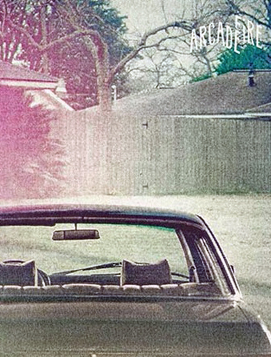Urban sprawl – development that occurs outward from a city’s centre – was deemed a good idea in the 70s. It is within this cycle of social and infrastructural growth and decay that Arcade Fire have released their latest record, The Suburbs…
In this three part series, Theo Sangster makes a connection between current social trends, and three of 2010’s biggest record releases. These are Vampire Weekend’s ‘Contra’, The National’s ‘High Violet’, and ‘The Suburbs’ by Arcade Fire. Read Theo Sangster’s first instalment, Music of the Moment Part 1, about Vampire Weekend album Contra here.
Music of the Moment, Part 2: Arcade Fire – The Suburbs
‘Urban sprawl’ is the term used in town planning to describe the type of development that occurs outward from a city’s centre to provide living space for its increasing population. It was deemed a good idea in the 70s, but the flight of the working classes into these new ‘sub-urbs’ effectively ghettoised inner city areas, with these derelict spaces undergoing subsequent gentrification.
It is within this cycle of social and infrastructural growth and decay that Arcade Fire have released their latest record. Having touched on similar themes in earlier releases (‘Funeral’, ‘Neon Bible’), ‘The Suburbs’ is a fully fledged endeavour into the love, loss, heartbreak, and distant memory of what it means to grow out of the twilight of suburban childhood, and into this somewhat confusing modern life.

The trailer for ‘Where the Wild Things Are’ explained things beautifully, with young Max, in full fantastical regalia, running amok with those big cuddly products of his imagination. Perhaps the most poignant part of that promotional clip was Arcade Fire’s ‘Wake Up’ padding out the onscreen adventure. The pairing between Spike Jonze’s acclaimed adaption of that generation-defining picture book, and Arcade Fire’s anthem to the loss of childhood innocence couldn’t have been more perfect. Arcade Fire have taken those themes in a deeper direction through ‘The Suburbs’, carving out a geo-social evolution that is relatable to everybody who has ears to listen.

The record launches into title track ‘The Suburbs’, where ‘all the houses they built in the 70s finally fall’, whilst ‘taking a drive’ through the tarmac and letterboxes which define the bleak landscape. The concept of a ‘suburban war’ is introduced, a great battle depicted in the Spike Jonze directed music video, where kids on bikes with BB guns fight soldiers armed with the real deal. But these children eventually grow up, pulled unwittingly into the dreaded 9 to 5. The hounding melancholic beat of ‘Ready to Start’ warns of the ‘businessmen (who will) drink (your) blood/like the kids in art school said they would’. The once playful boy is morphed into the ‘Modern Man’, a creature caught up in corporate insignificance.

‘Rococo’ moves us into the city itself, launching a full frontal attack on the ‘modern kids’ that ‘will eat right out of your hand’. Arcade Fire do not hide their disdain of their ‘hipster’ fan base, calling them out on wearing ‘colours all the same’, falling drunk out of ‘indie’ club nights, and ‘seeming so wild/ but they are so tame’. The track ‘City With No Children’ speaks for itself, whilst the feminine voice in ‘Empty Room’, in this case, the lovely Régine Chassagne, says ‘your name in an empty room’, back home, alone in the suburbs. The first half of the album ends in the two-part ‘Half Light (I and II)’, which illustrates the past through the sun-blanched eyes of memory, musing that ‘our heads are just houses, without enough windows’.
‘Suburban War’ opens the record’s second movement, recalling ideas introduced in the title track; the war, driving that great piece of urban artillery, the SUV; ‘the music that divides us into tribes’; the boy who ‘searches for (his love) in every passing car’. But again, that is all lost in the ‘wilderness downtown’. Standout track ‘We Used To Wait’ speaks of ‘how we used to wait for letters to arrive’; about how ‘something so small’, i.e. a letter, ‘can keep you alive’. The song speaks of the disconnect that can accompany our increasingly technological communication channels, and in an interesting turn, the interactive music video for the track uses that very same technology to reconnect the viewer to their childhood home (note: you need Google Chrome to view it).

The record ends with the triumphant ‘Sprawl (I and II)’. The first part (‘Flatland’) despondently answers the question ‘where do you kids live?’ with the fact they have ‘been searching every corner of the earth’. The second part describes suburbia as ‘dead shopping malls (rising) like mountains beyond mountains’, with the refrain that ‘we can never get away from the sprawl’. This admission is true on a very basic level. Just like the Arcade Fire, we are both product and reactant to our geographical and social setting, a fact ‘The Suburbs’ brings to light with an overt, clear-eyed, and chart-topping execution.
By Theo Sangster, 28 November 2010.


Leave a Reply